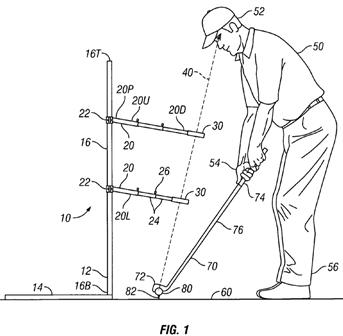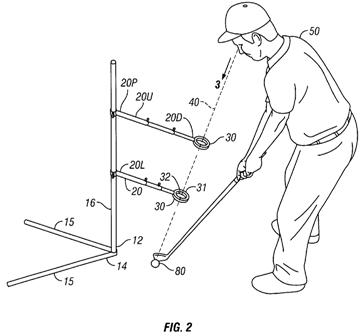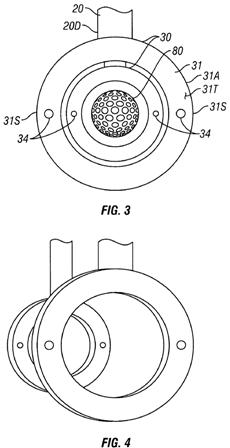A Training Device for Golfers Lacking a Caddy to Hold a Club Against Their Head During Practice
You have seen the pictures of the faithful caddy holding a club so the grip is against their player’s head as the pro beats balls on the range. The following training product is for all of us that can’t find someone crazy enough to carry our sticks in exchange for a percentage of our on-course earnings. You be the judge, would this golf training product help your game?



The patent goes on to explain:
The invention relates to a golf sighting system. More particularly, the invention relates to system that employs two rings, placed within the golfer’s visual path, to provide feedback to the golfer about undesirable head movements during the golfer’s complete golf swing.
Cultivating a proper golf swing is one of the most difficult and time consuming activities, comparable to the most complex of all sporting skills. Beyond the mechanics of the proper swing itself, a key element is controlling and preventing extraneous body movements. Such movements can “throw off” the swing, and be the difference between achieving phenomenal results, and achieving mediocre to poor results.
Among the movements that a good golfer has under control, is head movements during the swing. In particular, with regard to the backswing, the head should not move. In this regard, while a little side to side movement may be acceptable, vertical or up and down movement during the backswing can have disastrous consequences on the ensuing forward swing. It should be further noted that such head movements are often merely symptomatic of body movements that end up altering the position of the head.
In addition, a significant element in the golf swing is proper positioning of the body with respect to the ball. In particular, getting too close to the ball will alter the posture and thus the swing. Accordingly, proper body positioning of the more difficult aspects for a golfer to regulate. Thus, once a golfer makes a successful shot, it is often difficult to duplicate that shot, since it is difficult for the golfer to duplicate the exact position of the ball, and the exact positioning of the golfer with respect to that ball.
To date, a myriad of training techniques and devices have been proposed that seek to train the golfer to eliminate extraneous head movements. None of these systems, methods, or devices offer the immediate visual feedback provided by the present invention.
.
.
.
Accordingly, just prior to hitting the ball, the golfer gazes through the rings 30 and notices the ball 80 perfectly centered within both rings 30, and the alignment indicia 34 for both rings in a straight line. As the golfer takes a backswing, and then begins the forward swing, if he has extraneous body movements that in cause his head to move, he will immediately notice such movement in the form of misalignment of the ball 80, rings 30, and alignment indicia 34. If the golfer properly swings the golf club without extraneous movements, just after the golfer hits the ball, he will see the rings 30 and indicia 34 just as in FIG. 3, except with the ball 80 missing. When the golfer takes a proper, full golf swing, after he connects with the ball and follows through to the completion of the golf swing, his weight will shift toward the forward of his two feet, and his head will begin to turn. As his head turns, his view of the rings 30 will change. Provided extraneous body and head movements have not take place and the head turns in the correct plane, the golfers will observe the rings 30 cross, as indicated in FIG. 4, with the alignment indicia “moving” relative to each other along a straight line. If the alignment indicia are offset, and not viewed on a straight line as the golfer turns his head, then the golfer is given immediate feedback about extraneous head or body movements during the swing follow-through.
My prediction… it is more likely to make my swing worse.
